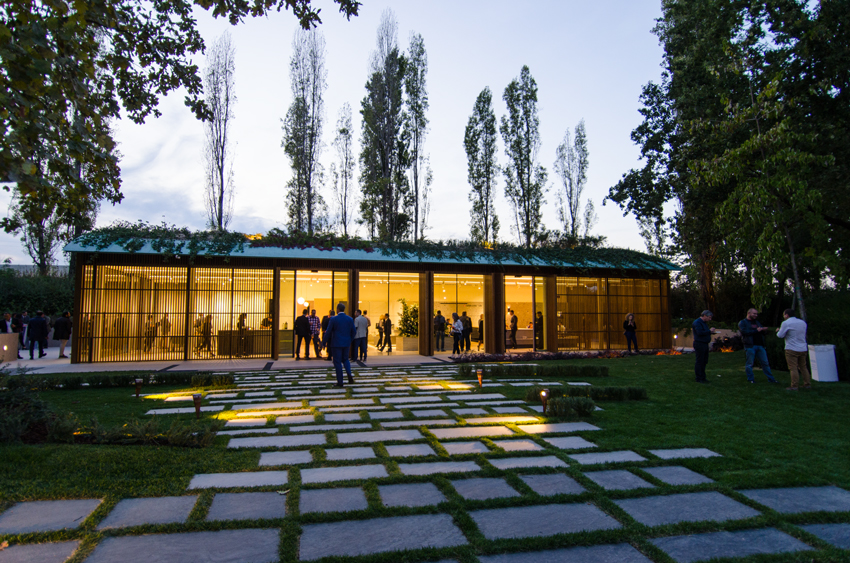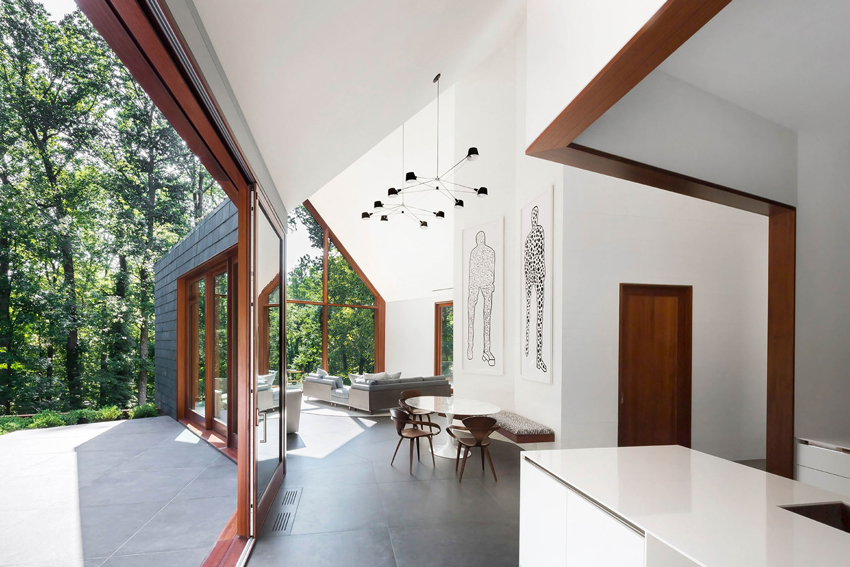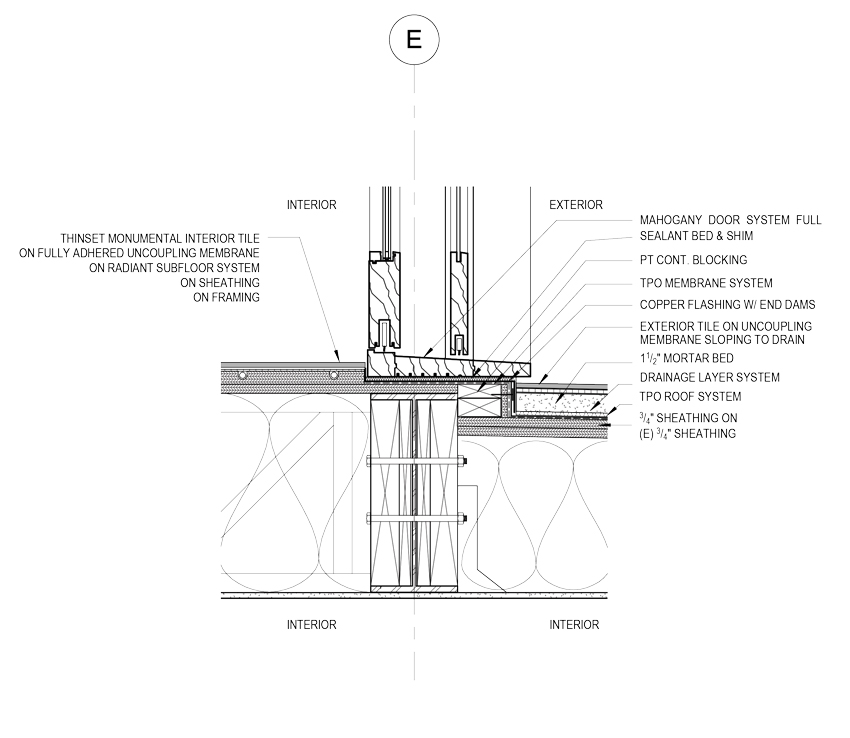Innovations That Drive Sustainable Ceramic Material Selection
Durable Porcelain Stoneware
Design professionals are exploring the advantages of exterior porcelain cladding that is resulting in numerous prize-winning green buildings. One of these, the new Reale Group office in Turin Italy, is designed to meet LEED Platinum Standards and features lightweight composite panels constructed of large-format porcelain slabs. The composition is an orchestrated design that includes alternations of glass and porcelain. The architects, lotti + Pavrani and Artecna studios, along with the engineering company Tosseti, developed a thin facade without grout at the edges of the angular recesses of the building. The color and texture of the finish surface were selected to complement the adjacent historic facades as required by city planners.
New ceramic technologies have allowed for the production of stoneware porcelain products of almost every size and thickness. An almost unlimited range of porcelain products are available for use in interiors and exteriors from floors to walls, roofing to cladding. Exterior porcelain panels can be specified in sizes as large as 5.25 by 10.5 feet with an unlimited palette of textures and colors. Thicknesses range from 3 to 20 millimeters (1⁄8–3⁄4 inch). Some of the advantages of using porcelain tiles as exterior surfaces include the reduction of joints, the ability to specify unique sizes and geometries, as well as the sustainability of the raw material. For example, manufacturers are providing porcelain “slate” roof surfaces that:
- Are resistant to atmospheric agents and ultraviolet (UV) light
- Are resistant to chemical and inalterable to the biological agents
- Have water absorption < 0.1 percent
- Are frost resistant and weatherproof
- Have high impact resistance
- Are wind resistant
- Are easy to install
- Are scratch resistant
Whether on the roof or on the ground, exterior landscape tiles resist wear and provide alternatives to heavier materials. One benefit of large-format thin porcelain panels and tiles is they are both light and strong enough so that unlike similar materials, a shipper can stack 20 tiles on one palette, saving on shipping costs and environmental impacts.

Photo: © Atlas Concorde
The new pavilion and tile showroom of the Atlas Concorde winter gardens demonstrate a varied application of porcelain tiles, including outdoors. The 20-millimeter (3⁄4-inch) exterior tiles are used in the interior to provide surface continuity.
Large Lightweight Porcelain Panels
Large porcelain stoneware panels that can be used in place of stone or other cladding materials are transforming the building industry. In July 2009, new types of large stoneware slabs were developed by an Italian manufacturer who since then has licensed this product throughout the world.4 A description of this process provides a look at how highly engineered computer controls are providing new ceramic building and landscape materials.
Raw Materials
The control of raw materials starts with the selection of basic components of clays, sands, and feldspars. Here is where a manufacturer with a life-cycle certification will select materials that meet sustainable guidelines. A computerized quality check by an automatic computerized weighing and dispensing system delivers the exact amount of each ingredient. This material is conveyed to a continuous mill that assures fine clay “paste” or “slip” with approximately 30 percent moisture content. The liquid suspension is subjected to high pressure and becomes an atomized dust that is the ideal consistency for subsequent production with a moisture level at approximately 0.5 percent.
Pressing and Surface Treatments
The atomized dust is loaded into a hopper and passed through sieves or filters to remove impurities and delivered to various dispensers, where some will be treated to provide specific surface effects. The material is then conveyed to new hydraulic presses with computer control units. State-of-the-art stainless-steel presses can exert pressures of up to 15,000 tons. This removes most of the air in the granules of the dust mix. Traditional dust presses use rams to compact dust contained in a mold or dies.
Finishing
Slabs are fired in natural-gas kilns with special gas burners to a temperature above 1,200 degrees Celsius. A quality check assures that finished slabs are perfectly flat, the right size, and have no internal stresses. The entire production process consumes less energy and releases fewer pollutants and less CO2 into the atmosphere. A final quality exit check completes the firing sequence.
This process results in porcelain stoneware slabs that are then cut according to the required measurements. Gluing production lines add fiberglass underlayment backing systems that improve the tiles mechanical strength and provide additional bending and shock resistance. Cutting machinery snap-cuts tiles to the exact formats and a computerized digital-control grinder is used for those panels with fiberglass backing.
Finishing systems for the slabs employ computer silkscreen printers that can apply background dyes, a range of graphic designs, and protective surface glazes. Combined with a multi-head digital ink-jet printer operating as a plotter, repeated passes over the slab ensure high-resolution patterns or pictures. There is no limit to the graphic designs possible. This process is also used in smaller format ceramics.
Large-format thin porcelain tiles are a new material that is now being considered by architects around the world for both interior and exterior projects. The following case study provides an example of how Ziger/Snead Architects used large-format tiles to express their unique ecological vision at The Slate House.

Photo: © Jennifer Hughes Photography/Ziger/Snead Architects
High-performance ceramic tiles that can be used both inside and outside support the vision of the owners and architects in The Slate House, designed as a metaphor for healing, reflection, and relaxation.
Supporting Design When Details Count
The Slate House is surrounded by nature in a dense Maryland forest near Baltimore. The original ranch house was destroyed by fire, causing, as the architect, Douglas Bothner AIA, LEED AP partner at Ziger/Snead, describes “a physical, emotional, and ecological shift between owners, land, and surrounding ecology. Rising from the ashes of its predecessor, the design team set out to reconnect the site to the existing contextual environment. The home and gardens are designed as a metaphor for healing, reflection, and relaxation.” Large-format ceramic tiles were one of many key materials that the design team employed to express their vision.
Diminishing the line between interior and exterior environments was important to the design team. Slate wraps the exterior roof and walls, and charred wood caps the gable ends to evoke the memory of the former home. Large expanses of mahogany-framed window walls “maximize views of the surrounding forest, blurring interior and exterior spaces. Clean and direct geometries combine with natural materials of stone, wood, steel, and water to express rawness and simplicity,” according to Bothner. Simplifying material choices, he selected large, 4-by-4-foot ceramic tiles with properties that allowed them to be installed both on the inside of the house as well as the adjacent exterior patio. The mahogany sill and a small 2-inch step blur the line to the outdoors. Careful detailing supports the aesthetic intent.
Typically, a designer might choose bluestone outside and tile inside the house to achieve a similar effect, but this solution provided a seamless transition across the threshold by using the same material with different textures. Bothner reports that the firm selected a tile that exceeded minimums recommended by The Tile Council of North America (TCNA) and ANSI standards for both the interior and exterior surfaces. The specified tile exceeds DCOF 0.42, a standard that evaluates the traction of a surface or “coefficient of friction” under known conditions. For more information on this standard, TCNA provides additional resources and data on its website.5 The interior tile is smooth, and the exterior tile has been bush hammered to provide additional slip resistance.

Image: Ziger/Snead LLP Architects
Tile installation detail for The Slate House threshold. The interior tile is placed on a stiff floor surface designed to support the ceramic tile and a radiant floor surface. The exterior tiles are placed over an interior gallery below, and the detail shows the attention paid to moisture control and the prevention of thermal bridging.
Although identical ceramic products, each tile installation required different details. The exterior tiles are placed on a terrace over an interior gallery below. Both installations required that the wood floor trusses were designed to support a very stiff, flat, and stable flooring. Bothner reports, “Floor flatness and floor framing were designed to support the large-format ceramic tile and to reduce deflection, as tile has no strength in tension.”
There are numerous sustainable strategies employed in this super-insulated home. Another reason the architects chose ceramic flooring is because the owner wanted a radiant floor. So they specified a “warm board product,” a radiant subfloor system with a bond break and crack isolation membrane. The detail shows how this was incorporated into the flooring section. The tile edges are protected, both inside and outside, with metal floor profile edges. All windows and doors open for cross breezes in the summer to reduce the requirement for air conditioning.
A unique aspect of this installation is that the owner requested an alternative to mechanical air-supply registers in the flooring. The solution was to reinforce the floor tile at the register area with ¼-inch steel backing so the tile can span the width of the supply duct. A computer-controlled abrasive water-jet machine cut grooves into the reinforced ceramic tile to create a new ceramic supply register. The tiles were then tested for airflow before placement in the living areas.
Insulated, low-e glazed windows help reduce solar gain while allowing natural light to fill the spaces during the daytime and reduce energy loads. Bothner reports that the project exceeded the requirements of the 2012 International Energy Construction Code with an R-49 roof assembly, R-36 wall assembly, and windows with a 0.35 U-factor. Attention to detail, materials, and installation reinforce the visions of the owners and architects to transform this home in the woods.









